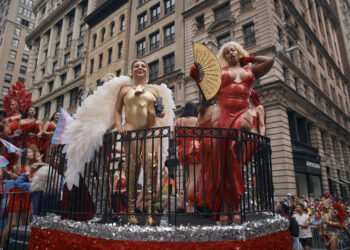For Schoenbrun, the draw isn’t the famous graves. Green-Wood has, for them, been a safe haven for reflection and transformation. In their first year taking hormones, Schoenbrun met friends here, who while lounging on a hill, took regular photographs to capture their physical evolution. Schoenbrun’s first in-person meeting with Brigette Lundy-Paine, one of the stars of “I Saw the TV Glow,” was here.
Schoenbrun wrote the film in late 2020, just a few months into their transition. In that fraught moment of becoming, the script poured out in a manic rush.
“I remember staggering out of my bedroom after I finished it and walking up to my partner and saying, ‘I can only do that so many times’ — that level of spilling my guts on the page,” Schoenbrun says.
By the time “I Saw the TV Glow” was nearing production, Schoenbrun was no longer in the same head space. They came to Green-Wood to make outlines and rekindle the “early transition terror” that had since passed.
“I was falling in love. I was having a more consistent feeling of comfortableness in my body in a way that I had never had,” Schoenbrun says. “And I was like, ‘(Expletive), I’m about to make this trauma movie.’”
“I Saw the TV Glow,” which A24 opens in theaters Friday, has, since its debut at the Sundance Film Festival, been hailed as an acutely intense psychodrama of self-discovery. In 1990s suburbia, an awkward loner named Owen (Justice Smith) encounters Maddy (Lundy-Paine), a cool, prickly older high school student who opens his eyes to a “Buffy the Vampire”-esque TV series called “The Pink Opaque.” It stars a pair of young women in battle with a supernatural villain named Mr. Melancholy.
Their obsession with the show — particularly Maddy’s — takes on a feverish quality. “The Pink Opaque” becomes something like a portal to…
Read the full article here








